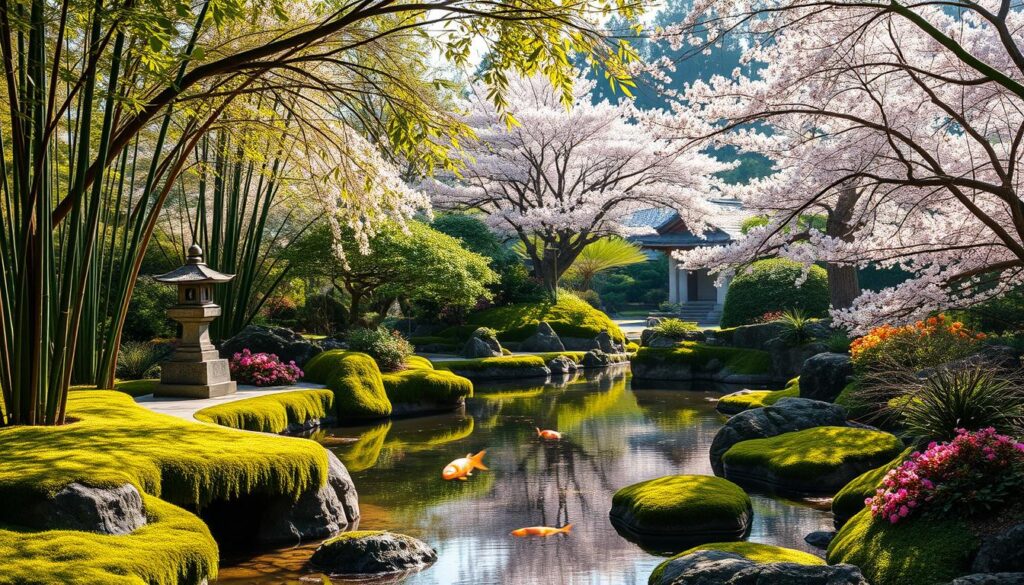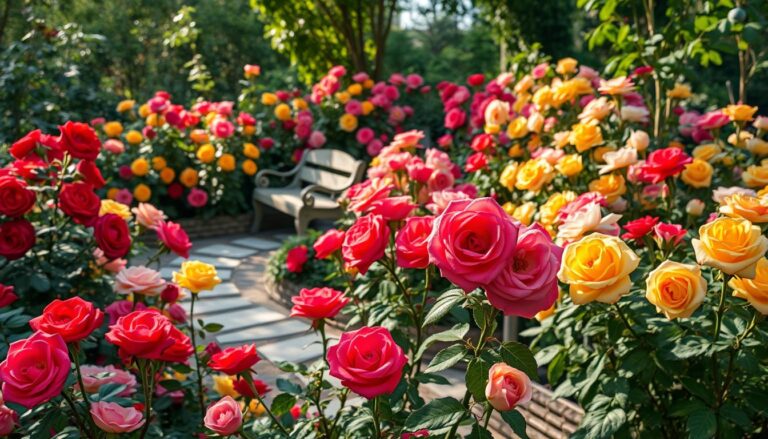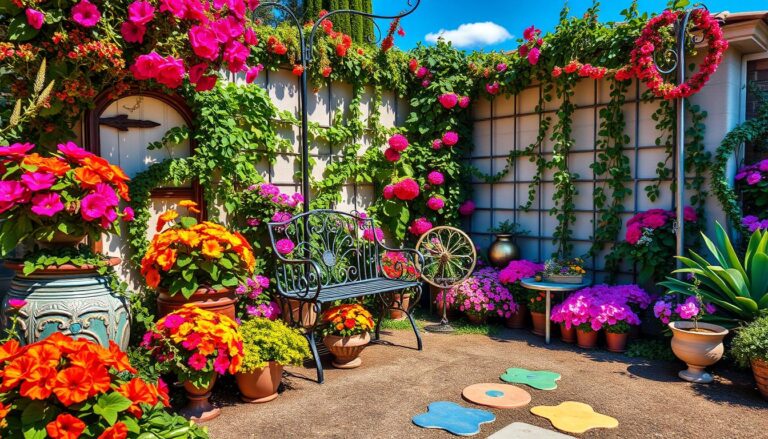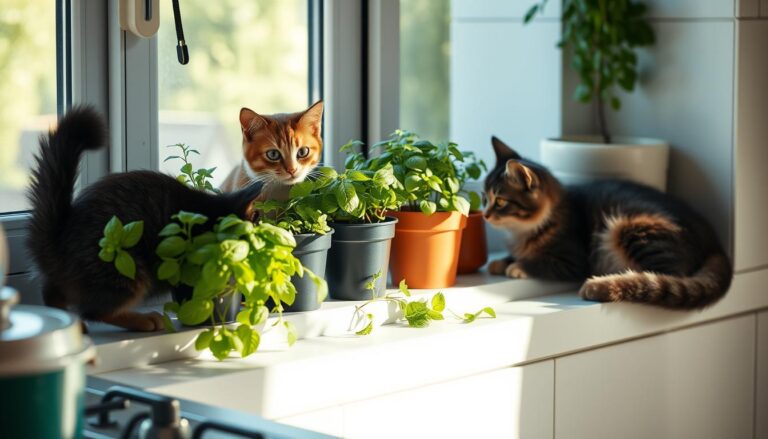Imagine stepping into a serene outdoor space that blends natural beauty with design. Japanese garden ideas can turn your yard into a peaceful retreat. They promote relaxation and well-being. You can make your yard a stunning oasis, showcasing nature’s beauty.
Japanese gardens use water, plants, and rocks to create balance and harmony. These elements help make your outdoor space peaceful. They invite you to relax and think deeply. You can make a small or large garden, depending on your preference.
Traditional Japanese garden design focuses on simplicity and natural materials. It can make your outdoor space unique and breathtaking. Adding bamboo, moss, and stone lanterns brings texture and color. Whether you’re experienced or new to gardening, Japanese ideas can help you create a beautiful space.
What is a Japanese Garden?
A Japanese garden is a special outdoor area. It uses natural things like water, plants, and rocks. This creates a calm and peaceful place. The idea is to live in harmony with nature.
When making a Japanese garden, picking the right japanese garden plants is key. Plants like bamboo and Japanese maples are popular. They help make the garden look natural and balanced.
Today, modern japanese garden ideas add new touches to the old ways. Yet, they keep the traditional Japanese garden feel. Elements like stone, water, and plants are used to achieve balance. This makes the garden a peaceful spot that shows nature’s beauty.
To start a Japanese garden, pick a few important things. A water feature, rocks, and japanese garden plants are good to begin with. Arrange them to bring balance and harmony to your garden.
Use simple, asymmetrical, and natural designs to guide you. By doing this, you can make a beautiful and calm outdoor space. It will show the beauty of Japanese garden design.
Types of Japanese Gardens
Japanese gardens are famous for their calm and natural beauty. They often use elements like japanese rock garden design to feel peaceful. You can get ideas from different types of gardens, like strolling, Zen, and tea gardens. For indoor spaces, think about using indoor japanese garden ideas, like small gardens or bonsai trees, to add nature inside.
A modern approach to japanese garden design might mix old and new. It could use stone lanterns and gravel with modern plants and materials. Some well-known Japanese gardens include:
- Strolling gardens, with winding paths and beautiful landscapes
- Zen gardens, focusing on simplicity and meditation
- Tea gardens, made for traditional Japanese tea ceremonies
These garden types can fit many spaces and styles. You can make a unique and calm outdoor area that shows your personal taste. By blending modern and traditional elements, you can create a special space.
| Garden Type | Description |
|---|---|
| Strolling Garden | A garden for walking and thinking |
| Zen Garden | A garden that focuses on simplicity and meditation |
| Tea Garden | A garden for traditional Japanese tea ceremonies |
Essential Features of Japanese Gardens
When designing your japanese garden ideas, it’s crucial to include key features. These elements add beauty and create a peaceful atmosphere. For small gardens, focusing on a few important features can make a big difference.
Water elements, like ponds and streams, are a must in traditional japanese garden design. They add beauty and create a calming sound. This makes your small garden even more relaxing.
Water Elements: Ponds and Streams
In traditional japanese gardens, water symbolizes life and nature’s connection to humans. Even a small pond or stream can bring tranquility to your garden.
Paths and Walkways
Meandering paths and walkways are key in japanese garden ideas. They let visitors enjoy the garden’s beauty. In traditional designs, these paths are made from natural materials like stone or wood. They guide visitors, creating a sense of wonder.
Rocks and Gravel
Rocks and gravel bring harmony and balance to japanese gardens. Rocks are arranged in patterns, like the “three-rock” formation, to symbolize heaven, humanity, and their connection. Gravel creates a sense of flow, guiding the visitor’s eye through the garden.
| Feature | Description |
|---|---|
| Water Elements | Ponds, streams, and waterfalls |
| Paths and Walkways | Meandering paths made of natural materials |
| Rocks and Gravel | Rocks arranged in specific patterns, gravel used to create flow and movement |
Plant Selection for Japanese Gardens
Choosing the right plants is key in a japanese garden. Trees, shrubs, and flowers set the garden’s mood. Modern gardens mix native and non-native plants to match the local weather.
Trees like Japanese maples and cherry trees add color and shape. Shrubs like rhododendrons and junipers bring texture and blooms. These plants make your garden special and beautiful.
When picking plants, think about:
- USDA Hardiness Zones: Pick plants that fit your area’s climate.
- Soil conditions: Some plants, like rhododendrons, need specific soil.
- Seasonal changes: Choose plants that look good all year, like cherry trees in spring.
By picking the right plants, you can make a peaceful outdoor space. Modern designs let you show off your style in a beautiful garden.
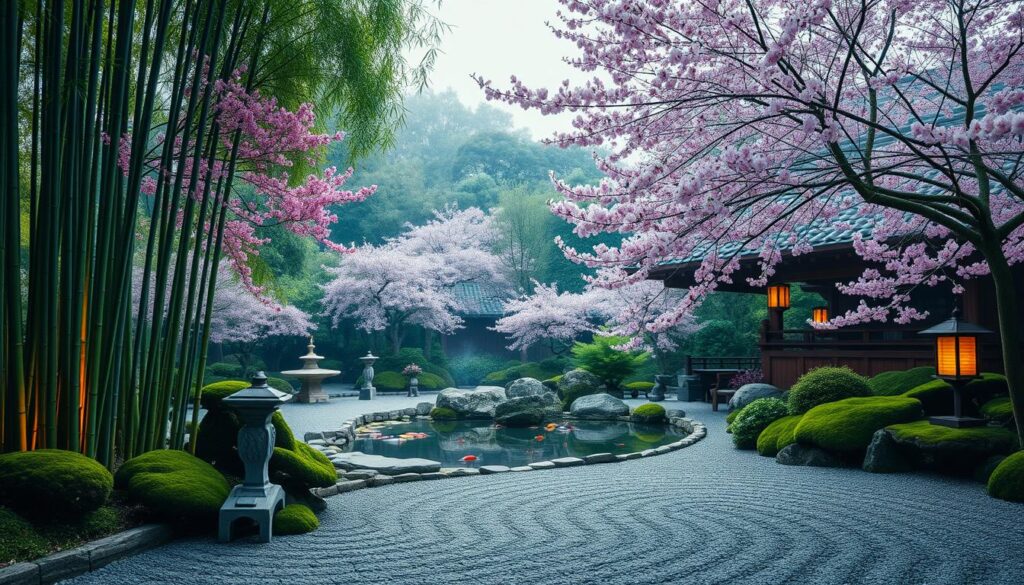
Japanese Garden Design Principles
Creating a japanese garden means following design principles from over 1,300 years in Japan. For the last 150 years, these principles have been used worldwide. They focus on simplicity, asymmetry, balance, and harmony, using natural materials. These ideas help make your outdoor space peaceful and serene.
When designing a small japanese garden, think about using natural materials like wood and stone. Balance and harmony come from how you place plants and features. Water elements, like ponds or streams, add tranquility. These elements help create a beautiful, peaceful garden that shows your style.
- Use natural materials, such as wood and stone, to create a harmonious balance.
- Incorporate water elements, such as ponds or streams, to add to the sense of tranquility and calmness.
- Consider the scale and viewer comfort when designing your garden, using proportional landforms, pathways, and plantings that relate to the human body.
By following these principles and tips, you can make a beautiful, peaceful japanese garden. It will reflect your style, no matter the size of your space.
| Design Principle | Description |
|---|---|
| Simplicity and Asymmetry | Emphasizes the use of simple, natural materials and asymmetric design to create a sense of balance and harmony. |
| Balance and Harmony | Creates a sense of tranquility and calmness through the placement of plants and other features. |
| Natural Material Use | Encourages the use of natural materials, such as wood and stone, to create a harmonious balance. |
Creating a Zen Garden
Creating a Zen garden means picking the right spot and design elements. A japanese rock garden design is a good start. You can also use indoor japanese garden ideas for a unique space.
First, pick a spot that gets partial shade to full sun, based on your plants. Think about the look you want, like traditional or japanese garden design modern. Mix sand, rocks, and plants for a beautiful design.
Key elements for your Zen garden include:
- Rocks and gravel for texture and depth
- Plants like bonsai or mosses with simple growth and green color
- A water feature, like a small fountain or pond, for a better sensory experience
To keep your Zen garden peaceful, rake gravel and remove debris often. With planning and detail, you’ll have a serene space for relaxation and mindfulness.
| Design Element | Description |
|---|---|
| Rocks and Gravel | Used to create texture and depth |
| Plants | Minimal growth and neutral green shades |
| Water Feature | Enhances sensory experience |
Incorporating Water Features
Water features are key in designing a peaceful japanese garden. Traditional designs often include ponds, streams, and fountains. These elements add beauty and calm. Even small features, like a fountain or birdbath, can create a serene atmosphere.
Water features in japanese gardens do more than look good. They help block out background noise, bringing calm. The sound of water is soothing, making it perfect for your garden. Popular features include koi ponds, tsukubai, and shishi-odoshi.
Benefits of Water in Japanese Gardens
Water features bring balance and harmony to japanese gardens. They also attract wildlife, enhancing the garden’s beauty and peace. This is a core principle of traditional design.
Ideas for Ponds and Fountains
There are many ways to add water features to your japanese garden. A small pond or fountain is great for small spaces. Consider a suikinkutsu for a unique sound. For a traditional look, think about a koi pond or tsukubai.
Accessories and Decorations
Creating a beautiful japanese garden is all about the right accessories and decorations. Plants, landscaping, and modern ideas all benefit from the right touches. Lanterns, statues, bridges, and trellises are popular choices.
These elements bring elegance and balance to your garden. A lantern can light up your space warmly. A statue can bring calm and serenity.
There are also small decorative items to enhance your garden. Ceramic pots and wooden planters add natural beauty. They’re great for showing off your plants.

Some top picks for plant containers include: * Ceramic pots * Wooden planters * Bamboo containers These containers bring natural beauty and uniqueness to your garden.
| Accessory | Description | Price Range |
|---|---|---|
| Lanterns | Traditional japanese lanterns | $100-$500 |
| Statues | Serene and calming statues | $200-$1000 |
| Bridges | Beautiful and functional bridges | $500-$2000 |
Adding these accessories and decorations makes your japanese garden beautiful and peaceful. It shows off your personal style and taste.
Maintenance Tips for Japanese Gardens
To keep your japanese garden ideas thriving, regular maintenance is key. A traditional japanese garden design needs attention to detail. This includes seasonal maintenance, pruning, and soil care. For small gardens, these tasks are crucial for a healthy and beautiful space.
Pruning trees and shrubs is a yearly task, with some needing more frequent care. The idea of “ramification” is also important. It means making the garden look like it has older, larger trees, even if it’s small. Using native plants and bonsai techniques helps create a unique garden.
- Prune trees and shrubs regularly to maintain shape and promote healthy growth
- Use native plants and incorporate techniques similar to bonsai to create a unique and beautiful garden
- Prioritize soil and fertilization guidelines to ensure a thriving garden
By following these tips, your japanese garden will always look its best. You can enjoy the beauty of a traditional garden, even in a small space.
Small Space Japanese Garden Ideas
Creating a peaceful space in small areas is easy with japanese rock garden design. You can use indoor japanese garden ideas and modern japanese garden design. Try vertical gardening to make the most of your space.
For small space japanese gardens, consider these tips:
- Use patios or balconies for a quiet outdoor area
- Add small ponds or fountains for calmness
- Gravel or sand can mark space and add visual interest
These ideas help make a beautiful, peaceful japanese garden in small areas. Choose native plants and adjust traditional ones for your local climate. Keep the essence of japanese landscaping in mind.
Balance elements like air, earth, water, and fire for harmony in your garden. With careful planning, you can make a stunning, serene small space japanese garden.
| Element | Percentage of Garden Space |
|---|---|
| Water Features | 10% |
| Plant Life | 30% |
| Hardscaping and Pathways | 60% |
DIY Japanese Garden Projects
Creating a Japanese garden in your backyard is a fun DIY project. It brings serenity and tranquility to your outdoor space. Start with key elements like water features, rocks, and plants.
A small Japanese garden can be just as beautiful. Think about the space between objects, called “ma,” for balance and harmony. Use natural materials like stone or wood for texture and interest.
Some DIY Japanese garden project ideas include:
- Creating a mini-pond or fountain for water sounds
- Building a wooden bridge or zigzag bridge for visual interest
- Planting native plants, such as bamboo or moss, for a low-maintenance garden
Consider your garden’s climate and aspect when designing. With creativity and planning, you can make a beautiful Japanese garden in your backyard.
| Japanese Garden Element | Description |
|---|---|
| Water Features | Ponds, fountains, or streams that add the sound of water to the garden |
| Rocks and Gravel | Natural materials used to add texture and interest to the garden |
| Plants | Native plants, such as bamboo or moss, used to create a low-maintenance and sustainable garden |
Inspiring Japanese Garden Examples
Starting your Japanese garden journey? Look for inspiration in famous gardens and homes. Explorejapanese garden plants
,japanese garden landscaping
, andmodern japanese garden ideas
to find new ideas for your garden.
Famous Japanese Gardens to Visit
Japan is full of stunning gardens. Visit the Zen gardens in Kyoto or Tokyo’s manicured landscapes. See the Kenroku-en in Kanazawa or the Adachi Museum of Art in Shimane.
Let their designs inspire your own garden makeover.
Homeowner Success Stories
In the U.S., many homeowners have created their own Japanese gardens. Diane Hunter visited over 80 Japanese gardens to create her own quarter-acre oasis. Another gardener traveled 400 miles to find the perfect trees for a serene pond and lush landscape on a $6,000 budget.
Unique Designs around the World
Japanese garden design isn’t just in Japan. See the Cowden Japanese Garden in Scotland or the Maymont Japanese Garden in Virginia. They show how Japanese garden ideas can be applied in new ways.
By looking at these examples, you’ll find lots of ideas for your ownjapanese garden landscaping
andjapanese garden plants
. Use the principles of simplicity, harmony, and nature to create a peaceful space that feels like Japan.
FAQ
What is a Japanese garden?
A Japanese garden is a special kind of garden. It focuses on peace and calm. It uses natural things like water, rocks, and plants to create this atmosphere.
What are the key elements of a Japanese garden?
Key elements include water features like ponds and streams. Also, rocks and gravel are placed carefully. And, plants like trees, shrubs, and flowers are chosen thoughtfully.
What are the different types of Japanese gardens?
There are strolling gardens, Zen gardens, and tea gardens. Each has its own design and elements.
How do I incorporate water features into a Japanese garden?
Water features are key in Japanese gardens. They can be ponds, fountains, or streams. It’s important to place them carefully to create a peaceful feel.
What plants are commonly used in Japanese gardens?
Plants like cherry blossoms, maples, bamboo, irises, and moss are common. Choosing plants carefully helps create balance and interest through the seasons.
What are the key design principles of Japanese gardens?
Key principles include simplicity, asymmetry, balance, and using natural materials. These principles help create harmony and tranquility.
How do I create a Zen garden?
To make a Zen garden, pick the right spot. Design it with sand and rocks. Add focal points like a Buddha statue or a small water feature. The goal is a peaceful space for meditation.
How do I maintain a Japanese garden?
Keeping a Japanese garden up requires regular care. Tasks include pruning, weeding, and fertilizing. Attention to detail is key to keeping it healthy and looking good.
Can I create a Japanese garden in a small space?
Yes, you can have a Japanese garden in a small space. Use vertical gardening, container gardening, and choose the right plants and materials.
Where can I find inspiration for my Japanese garden?
For inspiration, visit famous Japanese gardens. Look at homeowner success stories and unique designs. Observing nature and design principles can help you create a beautiful Japanese garden.

